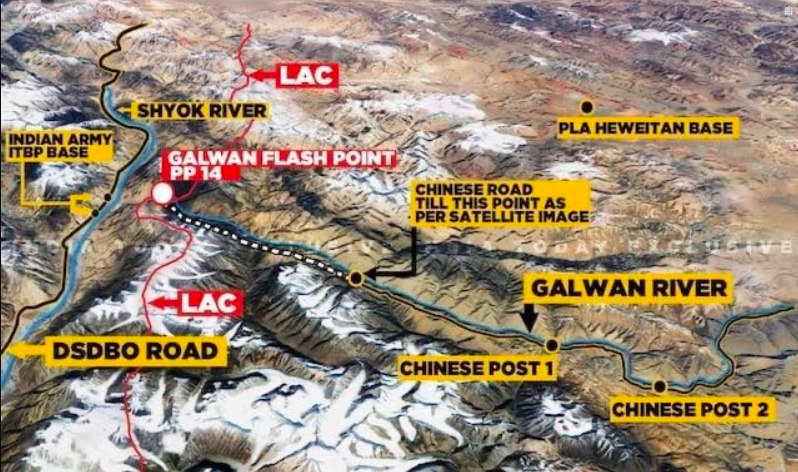What happened at the India-China border on the night of June 15 is undoubtedly the most serious clash in 45 years. It is now in public domain that several Indian soldiers – including a colonel – were killed in clashes with Chinese troops in Galwan valley in Eastern Ladakh. Reports indicate that there were major casualties on the Chinese side too though the numbers are not out because China has a strict censorship on news.
The reasons behind the Chinese aggression and Beijing’s assertive claims in the Galwan valley has both international and local dimensions. Internationally, China finds itself deeply isolated with no friends on its side after the outbreak of the Coronavirus pandemic. The US, Europe, Australia and other nations are after China’s nerve for having been deliberately casual in announcing the details of the virus and for not warning other nations of the outbreak on time. They want a thorough enquiry which China is trying to stonewall.
It is noteworthy that India has joined the diplomatic chorus for an independent investigation of coronavirus’s origins. India has also supported moves to invite Taiwan to the World Health Organisation as an observer. Both moves are absolutely legitimate. This has upset and angered the Red Giant.
The incident at the Line of Actual Control (LAC) in Galwan Valley should be seen in this light. Beijing wants to send a strong signal to India to keep off such moves against China and also send out a message that when it comes to Asia, it is Beijing that holds the steering wheel and the whip.

If this is the Chinese intention, a resurgent India should adamantly and deliberately do exactly what the Chinese don’t want. If India is bold enough, New Delhi should take up strong and undiluted diplomatic countermeasures against Beijing by denouncing the revocation of Hong Kong’s autonomy; it should also criticise human rights violations in Xinjiang and Tibet and give strong signals that it is ready to start official diplomatic engagements with China’s sworn enemy — Taipei.
The time has also come for India to challenge China’s dominance over the region by closely working with Indo-Pacific democracies.
Additionally, India should use trade as a weapon by imposing sanctions against Chinese imports. Beijing has huge investments in India at stake and it would be naïve on the part of China to think that it can kill our soldiers at the LAC and also expect to benefit from our huge market. India should put all Chinese investments to harsh review.
It may be initially difficult because all the successful start-ups in India has huge China funding.

Beijing is also upset that India is emerging as an alternative to big ticket investments of companies from the West who are desperate to cut the dependency on China. India has already eased its environment rules and banned Chinese companies from acquiring stakes in Indian firms. This move should be further strengthened.
China has, of late, been getting away with its brash and aggressive behaviour because the Red Giant knows that other nations are nose deep in fighting the Coronavirus. Under the cover of the pandemic, China started testing international waters by getting Hong Kong under its grip; then, Beijing became aggressive in the South China Sea. Other nations made a few noises, but not strong enough to upset Beijing.
Realising that the US is deeply engrossed in boosting its own economy and the November presidential elections and other nations are more bothered about fighting the virus, China turned its gaze to India and took to land-grabbing at the Galwan Valley. Whenever China is in trouble, Galwan ‘’burns’’.
China has been having a lurking feeling that it can arm-twist India; it also wants to remind New Delhi of its weaknesses by rekindling memories of the 1962 war. Just before the 1962 India-China war, New Delhi and Beijing accused each other’s troops of trespassing in the very same Galwan valley. Thus, Beijing could be using the latest Galwan valley standoff to press India’s psychological buttons by reminding it of 1962. But China knows that India of 2020 under Narendra Modi is vastly different from that of Jawaharlal Nehru’s India of 1962.

On the domestic front, Beijing wants to desperately divert the attention of its people from economic gloom to nationalistic jingoism. Unemployment is rampant in China, its economy is in doldrums and there is an overall shoulder-drooping depression. What better way than start a war and whip up nationalism. This is what China did in 1962 when Mao wanted to launch the Great Cultural Revolution – first national pride, then introduce harsh reforms.
Then on 20 October 1975, Chinese forces had crossed over into Indian territory in south of Tulung La, and ambushed Assam Rifles jawans. The Chinese also fired at them, resulting in four deaths.
But this time it is different scenario that China is worried about. India has been aggressive in ramping up its infrastructure at the LAC with China by building roads and bridges; the latest being the road leading to the Daulat Baig Oldi air base which was opened last October. But nothing has changed at the Galwan Valley to provoke China, except Beijing’s deep fear of a resurgent India.

Before the Galwan skirmishes, Beijing has been surrounding India with a ring of troublesome neighbours. By investing deeply in Pakistan, Male, Lanka and Bangladesh, Beijing has ensured that these nations take an anti-India stand. The latest to join is Nepal which has suddenly become aggressive, thanks to tacit support from Beijing.
In a way, China has been successful in isolating India with its once-friendly neighbours. With all these nations on its side, China launched its misadventure at Galwan.
It should be flagged here that the violent clash between Indian and People’s Liberation Army (PLA) troops along the LAC occurred despite India and China having at least five border agreements and other mechanisms aimed at defusing border tensions. They include the 1993 agreement of maintenance of peace and tranquillity along the LAC, 1996 agreement of CBM (confidence building measure) in the military field along the LAC, 2005 protocol on the modalities of CBM in the military field along the LAC, 2012 agreement on the establishment of a working mechanism for consultation and coordination on India-China border affairs and 2013 border defence cooperation agreement.

Apart from the five agreements, a joint working group with political representatives of both China and India was formed in the 1980s. The JWG met several times but failed to reach any consensus on the border issue. Later, a special representative was appointed during PM Atal Bihari Vajpayee’s time in a bid to lower tensions at the border. However, the talks between the special representatives also failed to yield any result.
Diplomatic experts say that all the five agreements are heavily tilted in favour of China and hence have not resulted in the de-escalation of tensions along the LAC. Also, the experts say that there has been no clear demarcation of the LAC and both India and China have different perceptions of the border and that’s why clashes occur between the troops on the ground.
National Security Adviser Ajit Doval himself has had several rounds of talks aimed at resolving border disputes. But there has been no results due to the adamant stand taken by China. Every time India yields an inch, China will claim a few miles. Time has come for a change in our mindset and policy towards the Chinese.

But what is crucial is that in future, India has to have the bargaining chips to enter into a negotiation with China. The unfortunate part is that if India continues to deal with China the way it has been doing in the past, there will only be skirmishes and fatalities but no resolution of the conflict.
According to Lt Gen DS Hooda, former General Officer Commanding-in-Chief of the Indian army’s Northern Command, the situation at LAS is grave, could lead to greater tension. The future course of things will depend on what are the demands of the two sides and whether both are ready to reconcile.
“We don’t know much about the Chinese intentions this time as opposed to the Doklam or Chumar incidents. In these incidents, the problem was restricted to the construction of roads by the Chinese and we opposed it. I see this standoff leading to greater tension if what the Chinese want is unacceptable to us. If the Chinese agree to return to the original position along the LAC then the tension could ease. But, this time the Chinese don’t seem to be ready to vacate the areas.
“From our point of view, we need a firm strategy and show of strength on the ground with a clear message that they need to go back and restore the status quo ante. It is their responsibility also to respect the protocols. Once these broad principles are accepted, the details can be worked out. Our overall stance needs to be enunciated to the government of China,” Gen Hooda said in a statement to the media.
But one thing went against India’s favour. China won the first round of battle by activating its communication warfare. The Chinese went ballistic, accusing India of crossing the border and warning it against “unilateral action” while the Indian political and military leadership chose to react quite late in the day. Senior military officials feel China has once again been ahead in information warfare.

According to former Army Chief General VP Malik, “A clear message should have come from the political and diplomatic leadership”.
India, with its muted approach, allowed China to dominate the narrative, feel many in the army.
While diplomatic initiatives must continue, the Indian Army must stop talking and for a change start inflicting casualties. Does India have the political will to do so is something that will reflect on political leadership.
In a sign that India will not hesitate to take tougher steps, the Ministry of External Affairs said, “We remain firmly convinced of the need for maintenance of peace and tranquillity in the border areas and resolution of differences through dialogue. At the same time, we are also strongly committed to ensuring India’s sovereignty and territorial integrity.” But again, that is too soft an approach.
“We remain firmly convinced of the need for maintenance of peace and tranquillity in the border areas and resolution of differences through dialogue. At the same time, we are also strongly committed to ensuring India’s sovereignty and territorial integrity.”- Ministry of External Affairs
The Galwan clashes, the bloodiest India and China have experienced since 1975, shows the rising ferocity of the India-China engagement on the borders.
With one of the largest losses in recent years, an Indian retaliation is assured. But on a larger scale, China lost India on Tuesday.
At this point, the Chinese are well entrenched in Pangong Tso, while the Galwan Valley has become a face-off point. In far away Naku La, a Chinese presence has persisted at a place between the point India sees as the LAC (a ridge) and a stone wall (which China claims is the LAC).
But one thing is sure: even without further clashes, the stand-off is likely to continue through the summer and get more belligerent. India has promised to continue building border infrastructure, even at the risk of inviting further face-offs.
China may have seriously miscalculated its moves because India is now politically bound to take action as the Modi government will not yield and is no push-over.




















































